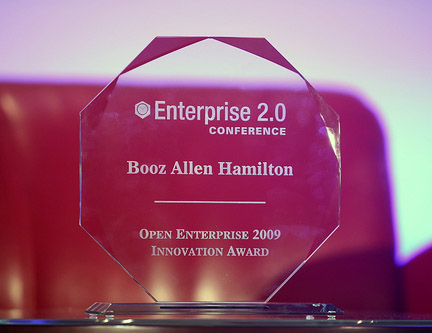A View from the Engine Room: Booz Allen Build a Collaborative Business

Two key members of the winning Booz Allen Hamilton 'Hello' team, to whom I presented the Open Enterprise 2009 trophy at June's Enterprise 20 conference in Boston, discuss the realities of their collaboration environment above.
Megan Murray & Donna Lucas are in the trenches working with technology and change management respectively at Booz Allen. This video is also available on the Open Enterprise 2009 site with a transcript, but I'm also posting it here as I believe it provides helpful insight into the realities of what it takes to get a collaboration environment going, and then to keep adoption and usage up.
Donna makes one of several great points six minutes into the video: change management includes dealing with 5,000 new employees a year in a 23,000 person company, which adds another facet to the complexity of keeping momentum and uptake bubbling.
While many people are still very jazzed about the promise of 'social media' (a term with as vague a focus as the '90's 'multimedia': basically disk-based rich interaction, largely superseded by broadband and Flash) in the marketing world, it is collaborative environments like Booz Allen Hamilton's which have real enduring substance.
Jerry Bowles picks up the news that ESPN are banning Twitter internally and that the US Marine Corps are quarantining Twitter, MySpace & Facebook on 'Social Media Today', noting
As much as the dreamers would like to think so, large-scale adoption of the architectures of participation is simply not going happen inside enterprises because that would represent a revolutionary change in organizational dynamics. Giving lots of individuals a voice and audience through a networked platform forces decision making to be more transparent, democratic and consensus-based. In my experience, most leaders do not want to operate their organizations as experiments in democracy so it's not going to happen.
What will happen instead--and is already happening--is that social media will become one more tool in the marketing/pr/communications toolbox. An important tool, but basically one more channel to be "managed" Official Twitterers will be designated and scripted. There will be no Scobles starting unapproved blogs under the radar. A lot of the spontaneity and diversity will disappear.
I'm very happy indeed for social media to be clearly defined as marketing/pr communications tools: there has been way to much blurring of internal collaboration and external marketing and influencing, which have fundamentally different goals.
Twitter for example, is essentially a fashionable bar. PR people have historically been typecast as having iron livers, hanging out in the place to be and buying drinks for key influencers. Twitter is the online version of a place where it's all about who you know and can interact with, but just like a PR professional in a bar you have know your craft and objectives.
'Loose lips sink ships' as the WWII Navy slogan put it: not many people really know how to use Twitter yet and like learning to drink you can be overheard saying some pretty silly things before you learn how to control your communications more effectively.
While Enterprise Collaboration may appear conservative, in fact 'large-scale adoption of the architectures of participation is happening inside enterprises and representing a revolutionary change in organizational dynamics', as Booz Allen and others are demonstrating.
Culture Eats Strategy for Breakfast (if you let it)
John Chambers of Cisco has reorganized the development aspects of that hugely successful international company around 'councils and chambers' as I've previously discussed here.
Ben Worthen writes today in The Wall Street Journal
...About 20% of the company’s senior leaders have left since the shift began in 2007—a percentage organizational experts call unusually high. Chambers compares the executives who’ve departed to basketball stars who don’t fit into a team’s system and adds that Cisco is better of without them despite their talent. He says the old Cisco, which relied on a handful of people to oversee new efforts, would never have been able to pursue so many opportunities.
Critics of the new structure say that it adds bureaucracy and strips away accountability. Cisco has lost market share in key product categories recently, and some people who have worked under the new structure draw a line between these losses and the management-by-committee approach. Like Booz Allen and the many other enterprises Stowe Boyd and I interviewed for 'Open Enterprise 2009', change isn't easy and the knives come out to protect turf very quickly as soon as any weakness is perceived. Collaboration is a team focused effort but humans are highly competitive; there are lots of people who equate longevity working for a company with seniority, regardless of their positive or negative contributions.
The core technologies that enable collaboration are common to the social media marketing world, but there the comparison ends. A short campaign to expose fizzy sugar water enthusiasts towards a particular brand by attempting to influence them with hand waving in the places they hang out is the absolute opposite to enterprise collaboration, which is all about getting people working together over time and build relationships.
 From John Chambers to Walton Smith and his BAH team members Megan Murray & Donna Lucas, huge changes are being carefully cultivated in the ways we collaborate to do business, changes which can be very scary to entrenched individuals and knowledge hoarding groups.
From John Chambers to Walton Smith and his BAH team members Megan Murray & Donna Lucas, huge changes are being carefully cultivated in the ways we collaborate to do business, changes which can be very scary to entrenched individuals and knowledge hoarding groups.
This is not easy work and can be politically dangerous and exposed for those fostering change, but the results for those who succeed will define broader best practice work processes for the future.